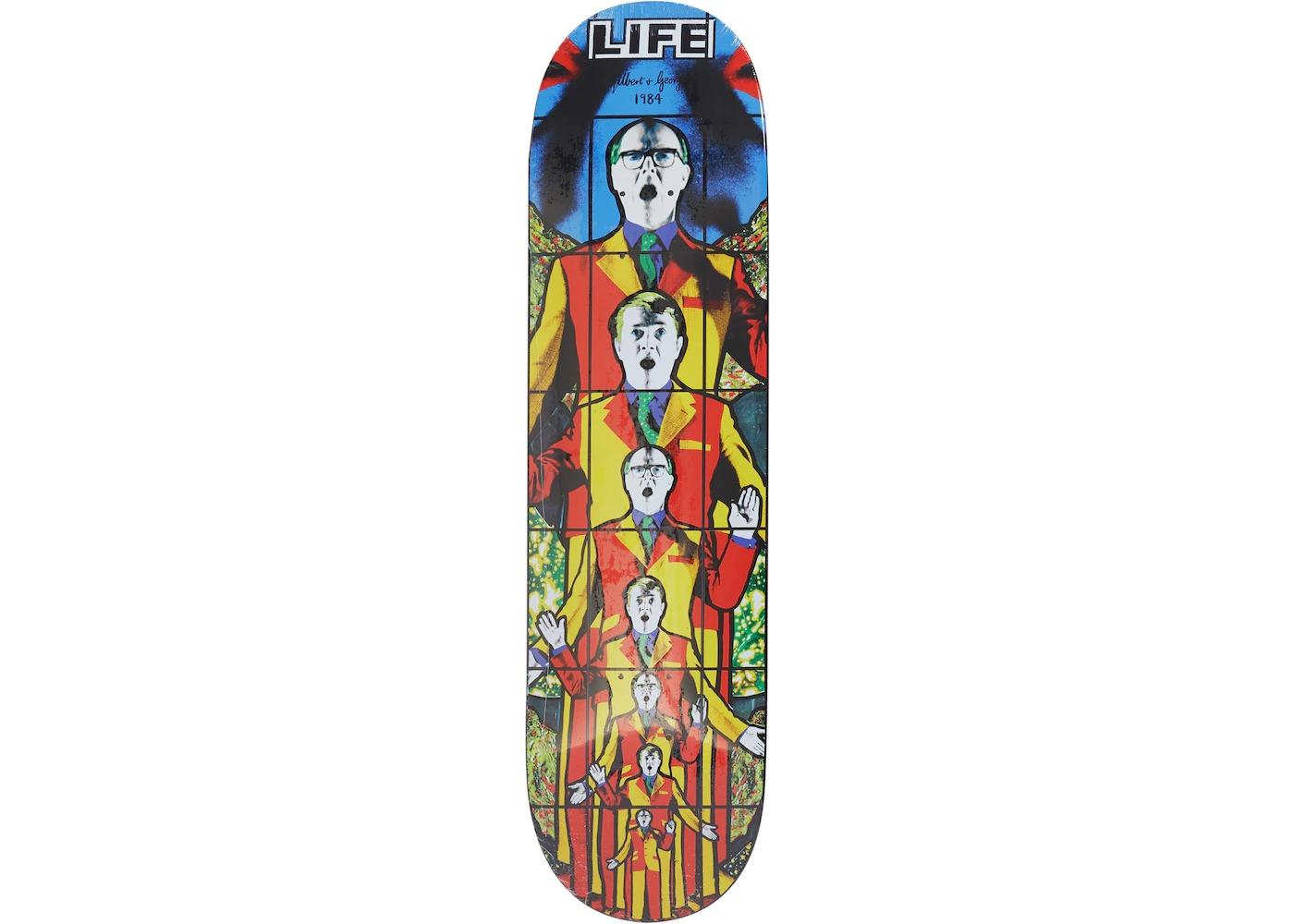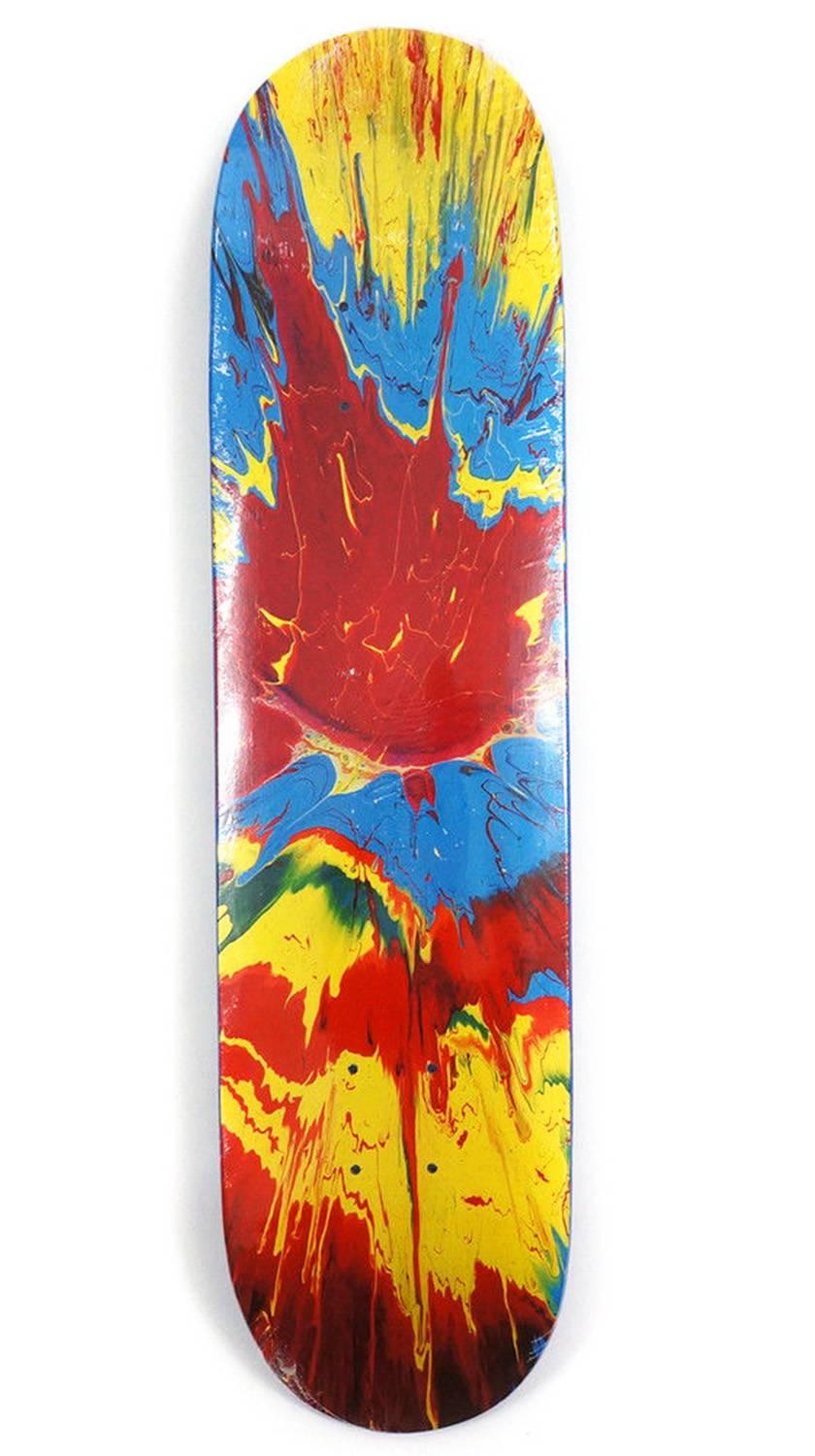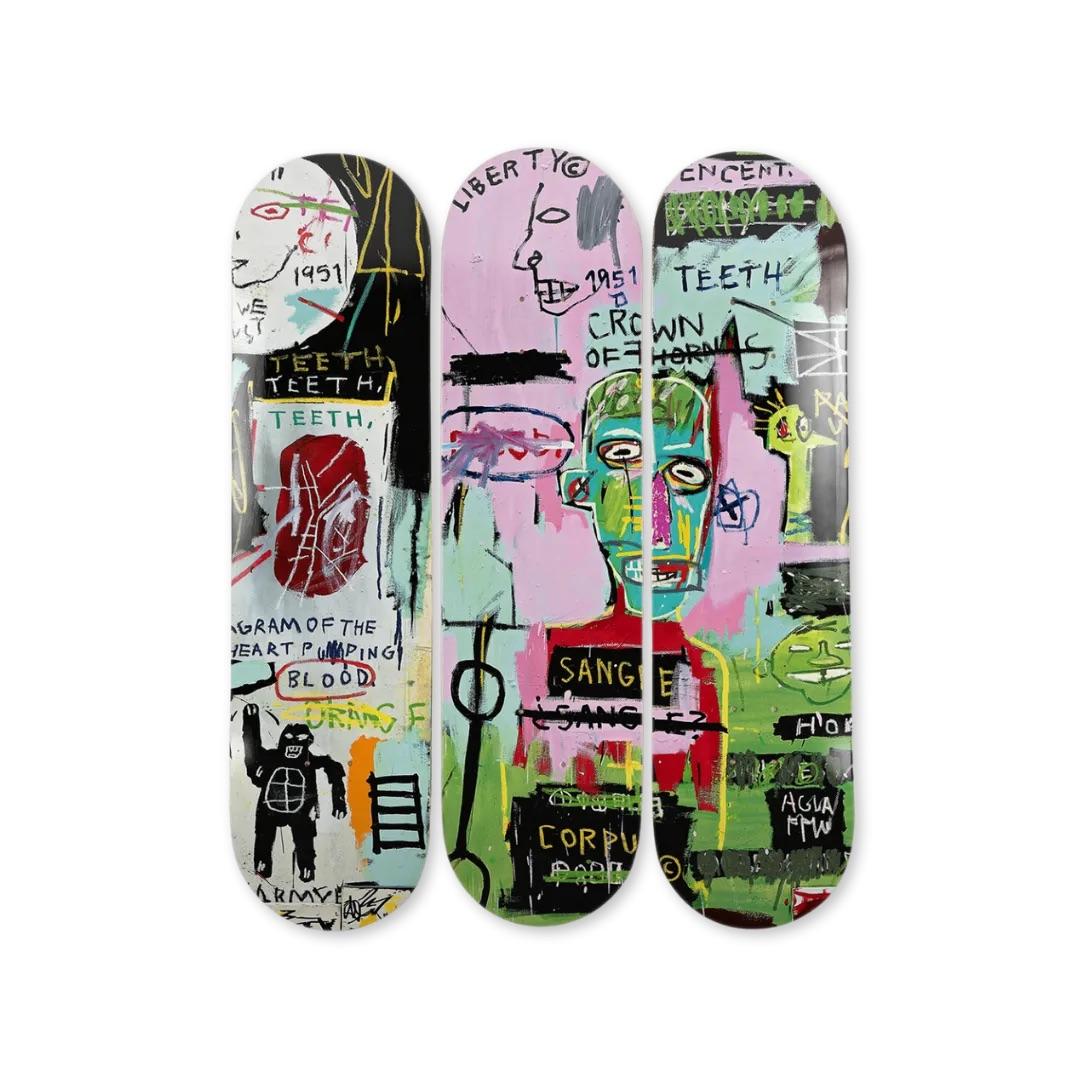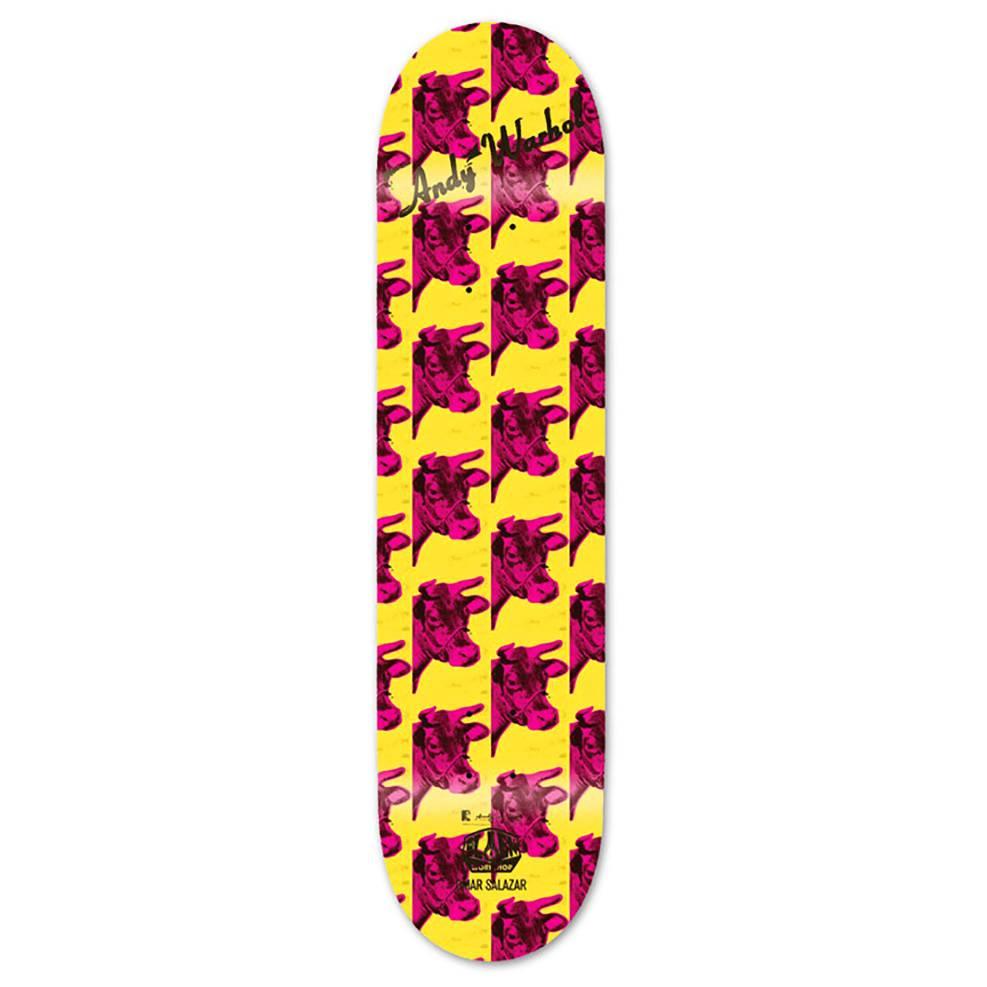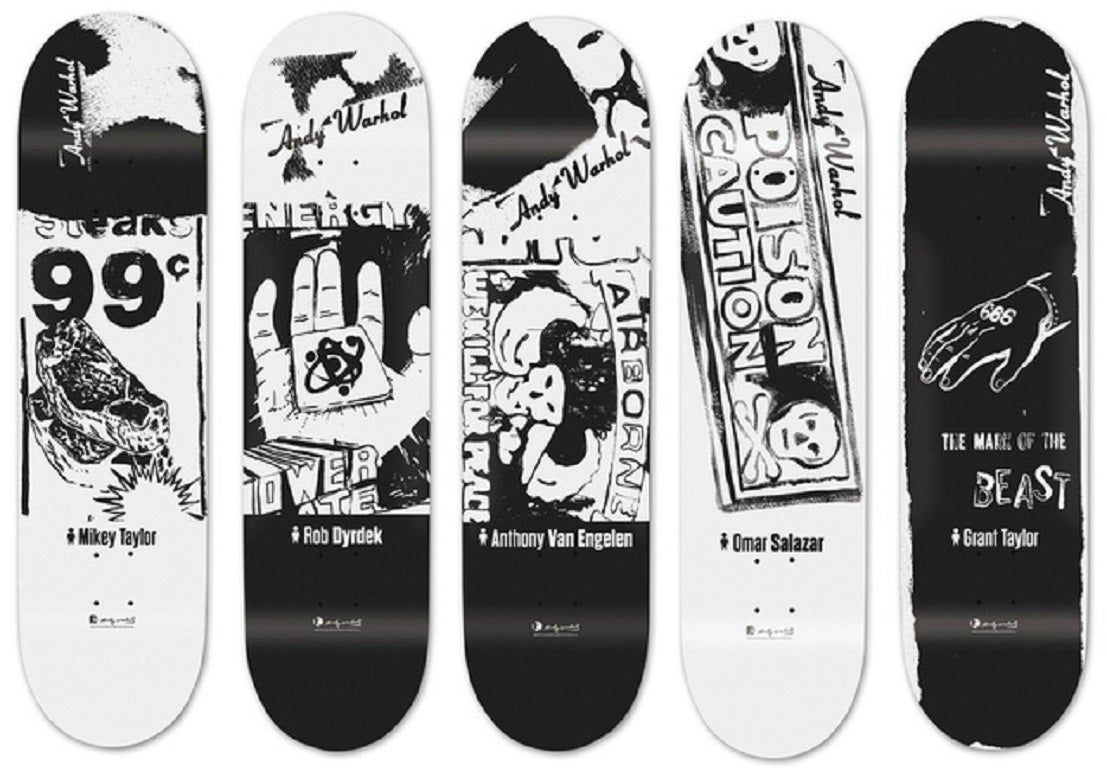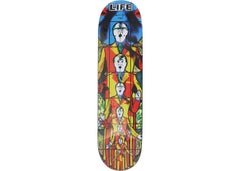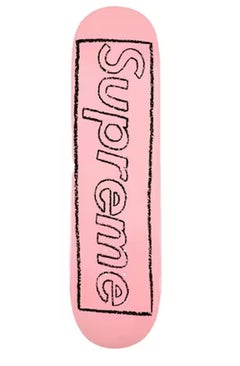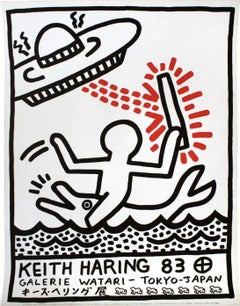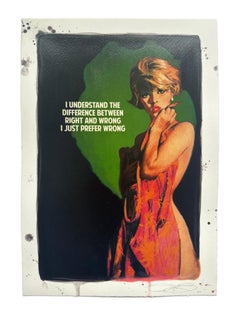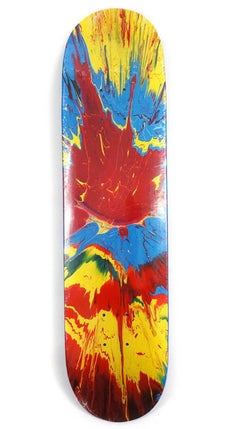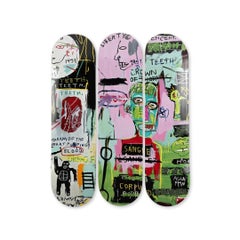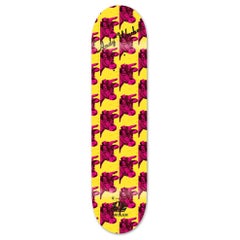Items Similar to Supreme x Gilbert & George DEATH Skateboard Deck
Want more images or videos?
Request additional images or videos from the seller
1 of 4
Supreme x Gilbert & George DEATH Skateboard Deck2019
2019
$953.44
£700
€820.47
CA$1,334.36
A$1,463.02
CHF 763.98
MX$17,605.59
NOK 9,628.71
SEK 9,053.46
DKK 6,127.37
About the Item
Supreme x Gilbert & George DEATH skate deck
2019
21.08 × 81.61cm / 8.3 X 32.13in
Maple wood
Unsigned, open edition
- Creation Year:2019
- Dimensions:Height: 32.13 in (81.61 cm)Width: 8.3 in (21.08 cm)
- Medium:
- Movement & Style:
- After:Gilbert & George (1942, British)
- Period:
- Condition:
- Gallery Location:Dubai, AE
- Reference Number:1stDibs: LU1608213789082
About the Seller
5.0
Vetted Professional Seller
Every seller passes strict standards for authenticity and reliability
Established in 2018
1stDibs seller since 2021
236 sales on 1stDibs
Typical response time: <1 hour
- ShippingRetrieving quote...Shipping from: London, United Kingdom
- Return Policy
Authenticity Guarantee
In the unlikely event there’s an issue with an item’s authenticity, contact us within 1 year for a full refund. DetailsMoney-Back Guarantee
If your item is not as described, is damaged in transit, or does not arrive, contact us within 7 days for a full refund. Details24-Hour Cancellation
You have a 24-hour grace period in which to reconsider your purchase, with no questions asked.Vetted Professional Sellers
Our world-class sellers must adhere to strict standards for service and quality, maintaining the integrity of our listings.Price-Match Guarantee
If you find that a seller listed the same item for a lower price elsewhere, we’ll match it.Trusted Global Delivery
Our best-in-class carrier network provides specialized shipping options worldwide, including custom delivery.More From This Seller
View AllSupreme x Gilbert & George - skate deck- open edition
By Gilbert & George
Located in Dubai, Dubai
Supreme x Gilbert & George LIFE Skateboard Deck
2019
21.08 × 81.61cm / 8.3 X 32.13in
screenprint on maple wood
unsigned, open edition
Category
2010s Contemporary More Art
Materials
Wood
KAWS x Supreme Chalk Logo Skateboard Deck Pink
By KAWS
Located in Dubai, Dubai
Chalk Logo Skateboard Deck, Pink
By KAWS
KAWS, the pseudonym of American artist Brian Donnelly, is widely recognized for his distinctive blend of street art and pop culture iconog...
Category
2010s Contemporary More Art
Materials
Plywood
Galerie Wateri after Keith Haring
By Keith Haring
Located in Dubai, Dubai
GALERIE WATERI EXHIBITION POSTER (Original)
After Keith Haring
1983
Offset lithography on Japanese pearlescent paper
68.58 x 50.8 cm
Category
20th Century Street Art Figurative Prints
Materials
Offset
I Understand Difference Btw Right & Wrong, I Prefer Wrong
By The Connor Brothers
Located in Dubai, Dubai
I Understand Difference Btw Right & Wrong, I Prefer Wrong
By The Connor Brothers
The Connor Brothers are a contemporary British art duo known for blending fiction with reality, oft...
Category
2010s Contemporary Figurative Prints
Materials
Pigment
Posters By Cy Twombly
By Cy Twombly
Located in Dubai, Dubai
Posters
After Cy Twombly
Cy Twombly's posters often reflect his expressive and gestural style, showcasing abstract marks, scribbles, and poetic text. These posters capture the ess...
Category
2010s Contemporary Abstract Paintings
Materials
Watercolor
Walk So Fast By Thierry Noir
By Thierry Noir
Located in Dubai, Dubai
Walk So Fast
By Thierry Noir
Thierry Noir is a French artist best known as one of the first to paint the Berlin Wall, turning it into a vibrant symbol of freedom and expression. H...
Category
2010s Contemporary Portrait Paintings
Materials
Canvas, Acrylic
You May Also Like
Damien Hirst Supreme Skateboard Deck
By Damien Hirst
Located in NEW YORK, NY
Damien Hirst Spin Series Skate Deck, Supreme 2009
Medium: Screenprint in colors on polychrome wood skateboard deck.
Dimensions: 31.1 x 7.68 in (78.99 x 19.51 cm).
Stamped signatur...
Category
1990s Pop Art More Art
Materials
Wood, Screen
Price Upon Request
JEAN-MICHEL BASQUIAT - In Italian. Skate Decks Pop Urban Art Design
By Jean-Michel Basquiat
Located in Madrid, Madrid
Jean-Michel Basquiat - In Italian
Date of creation: 2024
Medium: Digital print on Canadian maple wood
Edition: Open
Size: 80 x 20 cm (each skate)
Condition: In mint conditions and never displayed
This triptych is formed by three skate decks made of 7 ply grade A Canadian maple wood.
© Estate of Jean-Michel Basquiat. Licensed by Artestar, New York
In Italian (1983) is one of Jean-Michel Basquiat’s iconic works, created during a peak period of his artistic career. The piece reflects his distinctive style, blending graffiti, expressive brushwork, text, and symbolism. Like many of his paintings, "In Italian" presents a powerful and chaotic composition where words, figures, and signs interact in a raw and energetic visual language.
The title, In Italian, may suggest a reference to classical European culture—especially Italian Renaissance art—while at the same time subverting it through Basquiat’s urban, Afro-Caribbean perspective. His interest in contrasting high and low culture, refined and raw, is evident in this piece. The inclusion of text, often fragmented or cryptic, was one of Basquiat’s trademarks and serves here to provoke thought rather than deliver a clear message.
In this work, Basquiat explores themes such as identity, language, cultural heritage, and the appropriation of symbols. The figure depicted—alongside the textual elements—appears almost mythological or totemic, reinforcing Basquiat’s tendency to elevate marginalized characters into powerful, almost divine figures.
The brushstrokes are urgent, the colors bold, and the composition layered. It’s as if the viewer is meant to decipher a code—a mix of history, race, rebellion, and irony. Words in different languages, especially English and Italian, appear not to clarify meaning but to complicate it, suggesting the multilingual, multicultural environment Basquiat inhabited and commented on.
In Italian is a prime example of how Basquiat merged influences from the streets of New York with art history, African-American identity, and global culture. It's a bold visual statement that challenges traditional canons and forces the viewer to reconsider what art is, who gets to create it, and which voices are heard.
ABOUT THE ARTIST
Jean-Michel Basquiat (1960-1988) was one of the most influential artists of the 20th century, famous for his ability to fuse urban culture, social criticism and art history into a unique style. Born in Brooklyn, New York, to a Haitian father and Puerto Rican mother, his life and work were shaped by his multicultural heritage, the New York art scene and the social tensions of his time. Although his career was brief, his impact on contemporary art has been lasting and significant.
Basquiat showed an interest in art from an early age. His mother, Matilde Andrades, took him to museums and encouraged him to draw. At the age of seven, a car accident left him hospitalized for a time, and it was then that his mother gave him a copy of the anatomy book Gray's Anatomy, which influenced his fascination with the human body and its visual representation.
Despite his early talent, Basquiat's family life was turbulent. His mother was hospitalized for psychiatric problems and his relationship with his father, Gerard Basquiat, was troubled. This instability contributed to Basquiat dropping out of school at age 17 to pursue his artistic career on the streets of New York.
As a teenager, Basquiat joined the New York graffiti scene under the pseudonym SAMO (an acronym for "Same Old Shit"), which he used to sign his cryptic and poetic messages on the streets of Manhattan with his friend Al Diaz. SAMO's graffiti were a mixture of philosophical and social commentary on popular culture, capitalism and religion, and soon attracted the attention of the underground art scene.
In 1980, SAMO "died" when Basquiat and Diaz decided to end their collaboration, marking the beginning of Basquiat's transition from street graffiti to art galleries.
Basquiat emerged as a talent to watch in 1980, when he participated in the group exhibition The Times Square Show, which included other emerging artists from New York's Lower East Side scene. That same year, he attracted the attention of critics and collectors who saw in his work an electrifying blend of street art and neo-expressionism, the predominant movement of the time.
In 1981, art critic René Ricard published the influential essay The Radiant Child in Artforum magazine, which positioned Basquiat as one of the most promising artists of his generation. Shortly thereafter, he met renowned artist Andy Warhol, with whom he formed a close friendship and significant artistic collaboration. This association was instrumental in catapulting his career into the world of high art.
The collaboration with Warhol was a pivotal point in Basquiat's career. The two artists, although coming from very different worlds, shared a fascination with fame and popular culture. Together, they produced a series of works that combined Warhol's pop art icons with Basquiat's raw, spontaneous style.
However, this collaboration was also a source of controversy. Many critics accused Warhol of "exploiting" Basquiat, while others saw the collaboration as a creative dialogue between two genius minds. Although the criticism was mixed, there is no doubt that the relationship between the two artists helped cement Basquiat's reputation in the art world.
Basquiat's style is a unique amalgam of influences. His work is characterized by the use of dismembered human figures, skeletons and internal organs, evoking the fragility of the body and mortality. Basquiat also used symbols that alluded to African-American and African history, such as crowns, masks and references to historical figures such as Toussaint Louverture.
The use of text is another crucial aspect of his work. Words, phrases and numbers appeared in his paintings, often crossed out or overlapped, creating a sense of controlled chaos. These fragmented words provoked a non-linear reading of his works and conveyed multiple layers of meaning.
His art also reflected his concerns about racial issues, especially the place of people of African descent in Western art history and in society at large. The crowns that Basquiat often drew on his figures were a symbol of power and resistance, a way of proclaiming himself "king" in a world that had historically excluded black artists from the upper echelons of art.
In works such as The Death of Michael Stewart...
Category
2010s Pop Art More Art
Materials
Wood, Digital
Damien Hirst Supreme Skateboard Deck
By Damien Hirst
Located in NEW YORK, NY
Damien Hirst Spin Series Skate Deck, Supreme 2009
Medium: Screen print in colors on polychrome wood skateboard deck.
Excellent overal condition.
Dimensions: 31.1 x 7.68 in (78.99 x 19.51 cm).
Stamped signature and Supreme logo on reverse.
"Hirst first experimented with spin art in 1992 at his studio in Brixton (‘Beautiful Ray of Sunshine on a Rainy Day Painting and Beautiful Where Did All The Colour Go Painting’ (1992). The following year, he set up a spin art stall with fellow artist Angus Fairhurst at Joshua Compston’s artist led street fair, ‘A Féte Worse than Death’. Made up as clowns by performance artist Leigh Bowery, Fairhurst and Hirst invited visitors to pay £1 to create their own spin paintings to be signed by the pair, (and another £1 to drop their trousers and reveal their painted cocks and bollocks!)
The spin paintings are characterised by the works’ elongated titles, which begin with ‘Beautiful’ and end in ‘painting’, and their bright colours. The series began in earnest in 1994, when Hirst had a spin machine made whilst living in Berlin. A series of his machine-made spin drawings were subsequently exhibited at Bruno Brunnet Contemporary Fine Arts, Berlin, later that year. The exhibition ‘making beautiful drawings: an installation’, invited visitors to the gallery to make their own free drawings on a spin drawing machine made from a drill. The first Berlin-made spin painting exhibited was ‘Beautiful, pop, spinning ice creamy, whirling expanding painting’ (1995), at the Waddington Gallery, London, in 1995." (source: Damien Hirst site)
Related Categories:
Damien Hirst spin. Damien Hirst abstract. Damien Hirst skateboard...
Category
1990s Pop Art Prints and Multiples
Materials
Wood, Screen
Price Upon Request
Andy Warhol Cow Skate Deck 2010
By (after) Andy Warhol
Located in NEW YORK, NY
Vintage Andy Warhol Cow Skateboard Deck:
This work originated circa 2010 as a result of the collaboration between Alien Workshop and the Andy Warhol Foundation. A brilliant piece of...
Category
1960s Pop Art More Art
Materials
Offset, Wood
Ads Series skateboards set of 5
By Andy Warhol
Located in Washington , DC, DC
Ads Series skateboards set of 5
Category
21st Century and Contemporary Contemporary More Art
Materials
Screen
JEAN-MICHEL BASQUIAT - Horn Players, 1983 Skate Decks Pop Urban Art Design
By Jean-Michel Basquiat
Located in Madrid, Madrid
Jean-Michel Basquiat - Horn Players, 1983
Date of creation: 2024
Medium: Digital print on Canadian maple wood
Edition: Open
Size: 80 x 20 cm (each skate)
Condition: In mint conditions and never displayed
This triptych is formed by three skate decks made of 7 ply grade A Canadian maple wood.
© Estate of Jean-Michel Basquiat. Licensed by Artestar, New York
"Horn Players" (1983) is one of Jean-Michel Basquiat's most famous works, and a great example of his unique style, which blends graffiti, pop art, and expressionist painting. In this piece, Basquiat depicts two jazz musicians, probably inspired by legends like Charlie Parker and Dizzy Gillespie. The figures are stylized with exaggerated features, something typical of his work.
The painting is dominated by vibrant colors like yellow, red, and blue, with a background full of marks and strokes that give the sense of movement, as if you were hearing the music the characters are playing. Basquiat also incorporates text, such as the words “SAX” and “BIRD” (referring to Charlie "Bird" Parker), which not only provide more information about the characters but also add an extra layer of meaning, creating a connection between the music, the words, and the image.
The piece can be interpreted as a tribute to African American culture and its impact on music, especially jazz, which was born in that community. But it also reflects deeper themes of identity, as the musicians are not just represented physically but also symbolically, through the music and the words surrounding them. Basquiat, who often explored themes of race, power, violence, and inequality, uses this work to highlight how jazz serves as a form of expression and resistance for Black culture.
In 1983, when Basquiat created "Horn Players", he was already at the peak of his career. He had gained significant recognition in New York, and his work was widely acknowledged in the contemporary art world. This painting is part of a series where he pays homage to musicians and the history of jazz, a recurring theme in his work.
Additionally, there’s an interesting connection between Basquiat’s art and the world of skateboarding. Skateboarding, much like Basquiat’s art, is defined by its rebellious spirit, its focus on urban culture, and its drive for self-expression. Basquiat's graffiti-style brushstrokes, with their raw energy, evoke the same defiant attitude seen in skateboarding culture, where skaters, much like artists, break free from established norms and create something unique. The influence of graffiti, which is central to skateboarding’s aesthetic, is also present in Basquiat’s works, forming a natural link between these two worlds of rebellion and creativity.
"Horn Players" is a representative piece of Basquiat because it captures his vibrant style, his love for cultural references, and his ability to blend visual art with music. Moreover, it’s a work that celebrates Black culture, rebellion, and creative energy—values that also strongly resonate in the world of skateboarding. All of this showcases Basquiat’s mastery in merging different forms of artistic expression, connecting music, urban art, and the culture of resistance in a powerful work.
ABOUT THE ARTIST
Jean-Michel Basquiat (1960-1988) was one of the most influential artists of the 20th century, famous for his ability to fuse urban culture, social criticism and art history into a unique style. Born in Brooklyn, New York, to a Haitian father and Puerto Rican mother, his life and work were shaped by his multicultural heritage, the New York art scene and the social tensions of his time. Although his career was brief, his impact on contemporary art has been lasting and significant.
Basquiat showed an interest in art from an early age. His mother, Matilde Andrades, took him to museums and encouraged him to draw. At the age of seven, a car accident left him hospitalized for a time, and it was then that his mother gave him a copy of the anatomy book Gray's Anatomy, which influenced his fascination with the human body and its visual representation.
Despite his early talent, Basquiat's family life was turbulent. His mother was hospitalized for psychiatric problems and his relationship with his father, Gerard Basquiat, was troubled. This instability contributed to Basquiat dropping out of school at age 17 to pursue his artistic career on the streets of New York.
As a teenager, Basquiat joined the New York graffiti scene under the pseudonym SAMO (an acronym for "Same Old Shit"), which he used to sign his cryptic and poetic messages on the streets of Manhattan with his friend Al Diaz. SAMO's graffiti were a mixture of philosophical and social commentary on popular culture, capitalism and religion, and soon attracted the attention of the underground art scene.
In 1980, SAMO "died" when Basquiat and Diaz decided to end their collaboration, marking the beginning of Basquiat's transition from street graffiti to art galleries.
Basquiat emerged as a talent to watch in 1980, when he participated in the group exhibition The Times Square Show, which included other emerging artists from New York's Lower East Side scene. That same year, he attracted the attention of critics and collectors who saw in his work an electrifying blend of street art and neo-expressionism, the predominant movement of the time.
In 1981, art critic René Ricard published the influential essay The Radiant Child in Artforum magazine, which positioned Basquiat as one of the most promising artists of his generation. Shortly thereafter, he met renowned artist Andy Warhol, with whom he formed a close friendship and significant artistic collaboration. This association was instrumental in catapulting his career into the world of high art.
The collaboration with Warhol was a pivotal point in Basquiat's career. The two artists, although coming from very different worlds, shared a fascination with fame and popular culture. Together, they produced a series of works that combined Warhol's pop art icons with Basquiat's raw, spontaneous style.
However, this collaboration was also a source of controversy. Many critics accused Warhol of "exploiting" Basquiat, while others saw the collaboration as a creative dialogue between two genius minds. Although the criticism was mixed, there is no doubt that the relationship between the two artists helped cement Basquiat's reputation in the art world.
Basquiat's style is a unique amalgam of influences. His work is characterized by the use of dismembered human figures, skeletons and internal organs, evoking the fragility of the body and mortality. Basquiat also used symbols that alluded to African-American and African history, such as crowns, masks and references to historical figures such as Toussaint Louverture.
The use of text is another crucial aspect of his work. Words, phrases and numbers appeared in his paintings, often crossed out or overlapped, creating a sense of controlled chaos. These fragmented words provoked a non-linear reading of his works and conveyed multiple layers of meaning.
His art also reflected his concerns about racial issues, especially the place of people of African descent in Western art history and in society at large. The crowns that Basquiat often drew on his figures were a symbol of power and resistance, a way of proclaiming himself "king" in a world that had historically excluded black artists from the upper echelons of art.
In works such as The Death of Michael Stewart...
Category
2010s Pop Art More Art
Materials
Wood, Digital
More Ways To Browse
Skateboard Art
Skateboard Decks
Skateboard Art Decks
Supreme Skateboard
Supreme Deck
Supreme Skate
Nudie Suit
Original Oil Painting By William Verdult
Paul Morehouse
Philp Pot
Rudolf Staffel
Simone Bianchi
Stanley Tigerman
Stephen Posen
Takashi Murakami Posters
Tamara Karsavina
Tiffany And Co Rubber Stamp
Villa Cimbrone
